SBM4104: Analysis and Design of APIC IT Infrastructure Report
VerifiedAdded on 2023/01/18

APIC IT Infrastructure
Name of the Student
Name of the University
Author Note
Paraphrase This Document
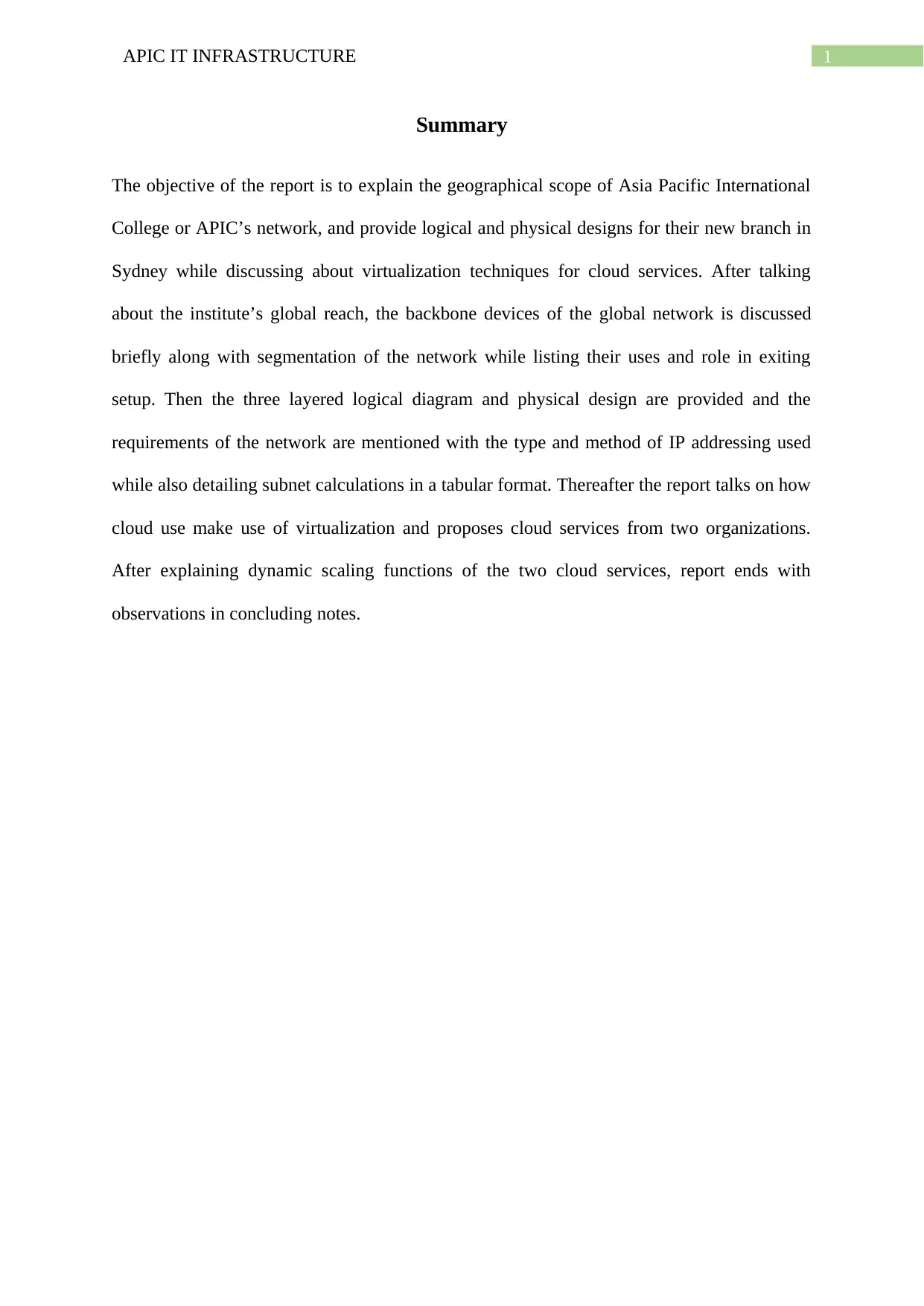
Summary
The objective of the report is to explain the geographical scope of Asia Pacific International
College or APIC’s network, and provide logical and physical designs for their new branch in
Sydney while discussing about virtualization techniques for cloud services. After talking
about the institute’s global reach, the backbone devices of the global network is discussed
briefly along with segmentation of the network while listing their uses and role in exiting
setup. Then the three layered logical diagram and physical design are provided and the
requirements of the network are mentioned with the type and method of IP addressing used
while also detailing subnet calculations in a tabular format. Thereafter the report talks on how
cloud use make use of virtualization and proposes cloud services from two organizations.
After explaining dynamic scaling functions of the two cloud services, report ends with
observations in concluding notes.

Table of Contents
Introduction................................................................................................................................3
Discussion..................................................................................................................................3
Geographical scope................................................................................................................3
Devices of Global Network................................................................................................4
Network Segments.............................................................................................................5
Advantages and use cases..................................................................................................5
Logical Network Design........................................................................................................6
Physical Network Design.......................................................................................................7
Virtualization and Cloud Computing.....................................................................................8
Cloud based solutions........................................................................................................8
Cloud Virtualization Techniques.......................................................................................9
Dynamic Scaling in AWS (Auto Scaling).......................................................................10
Dynamic Scaling in Microsoft Azure..............................................................................11
Recommendations....................................................................................................................12
Conclusion................................................................................................................................13
References................................................................................................................................14
⊘ This is a preview!⊘
Do you want full access?
Subscribe today to unlock all pages.

Trusted by 1+ million students worldwide
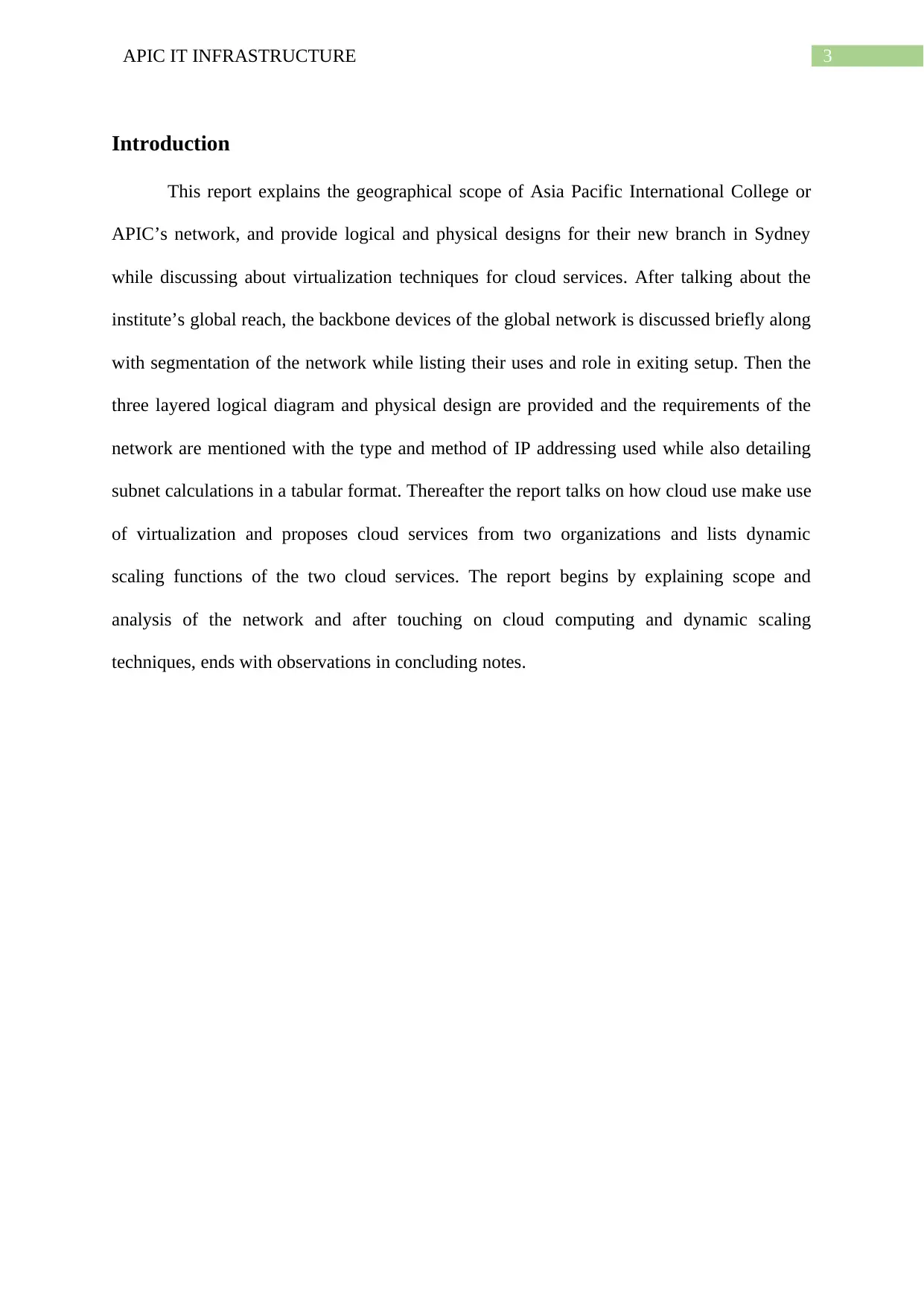
Introduction
This report explains the geographical scope of Asia Pacific International College or
APIC’s network, and provide logical and physical designs for their new branch in Sydney
while discussing about virtualization techniques for cloud services. After talking about the
institute’s global reach, the backbone devices of the global network is discussed briefly along
with segmentation of the network while listing their uses and role in exiting setup. Then the
three layered logical diagram and physical design are provided and the requirements of the
network are mentioned with the type and method of IP addressing used while also detailing
subnet calculations in a tabular format. Thereafter the report talks on how cloud use make use
of virtualization and proposes cloud services from two organizations and lists dynamic
scaling functions of the two cloud services. The report begins by explaining scope and
analysis of the network and after touching on cloud computing and dynamic scaling
techniques, ends with observations in concluding notes.
Paraphrase This Document
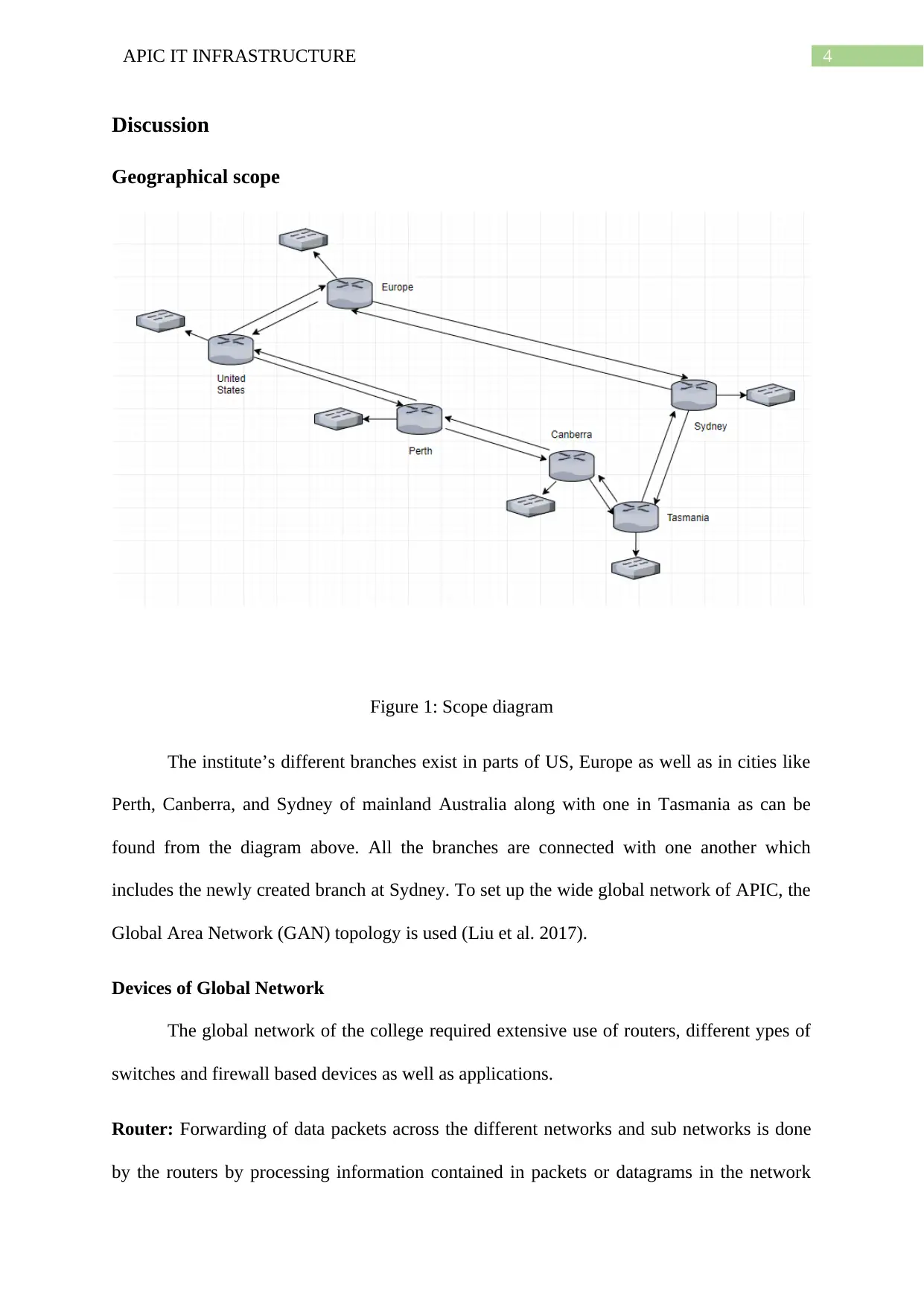
Discussion
Geographical scope
Figure 1: Scope diagram
The institute’s different branches exist in parts of US, Europe as well as in cities like
Perth, Canberra, and Sydney of mainland Australia along with one in Tasmania as can be
found from the diagram above. All the branches are connected with one another which
includes the newly created branch at Sydney. To set up the wide global network of APIC, the
Global Area Network (GAN) topology is used (Liu et al. 2017).
Devices of Global Network
The global network of the college required extensive use of routers, different ypes of
switches and firewall based devices as well as applications.
Router: Forwarding of data packets across the different networks and sub networks is done
by the routers by processing information contained in packets or datagrams in the network
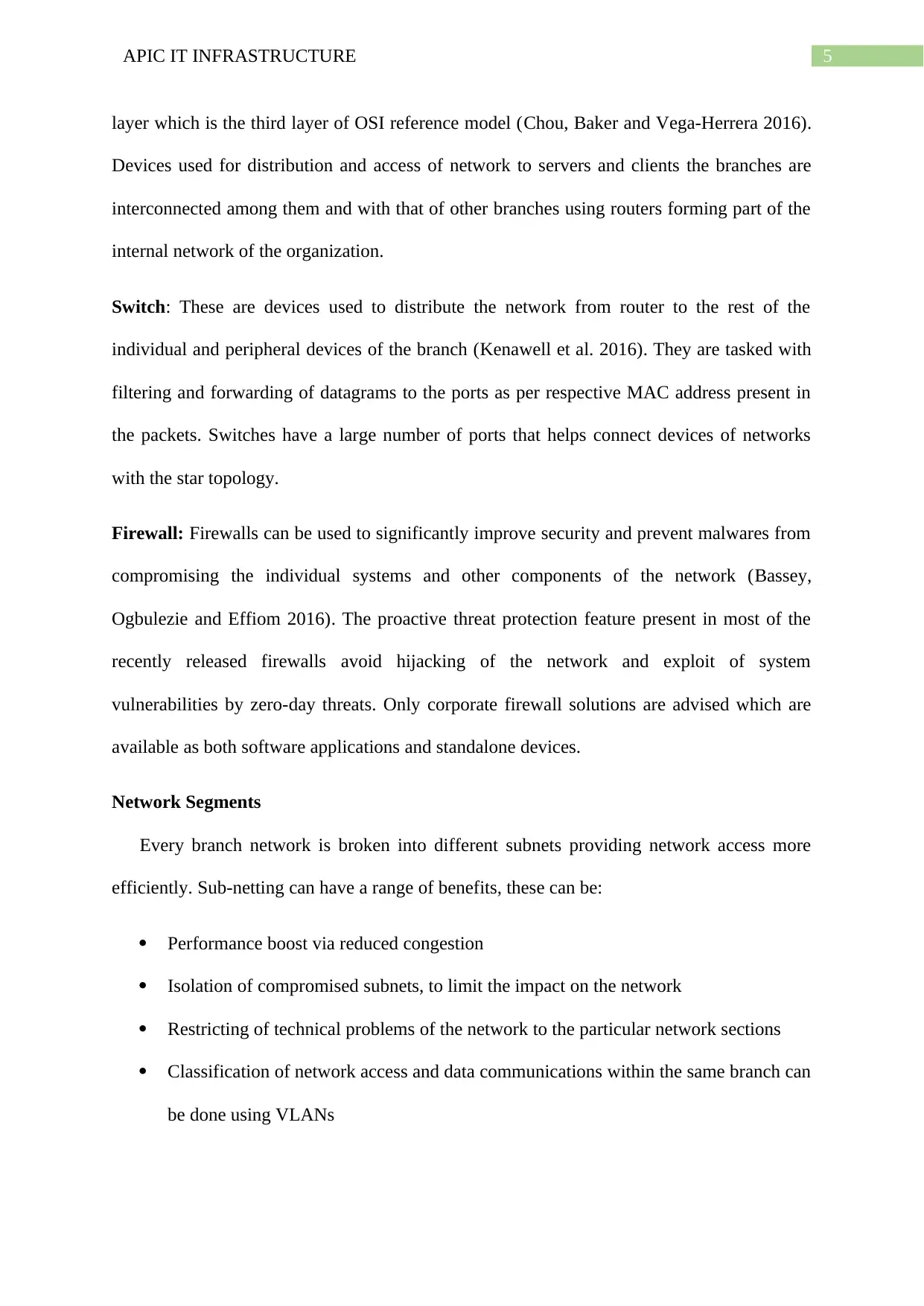
layer which is the third layer of OSI reference model (Chou, Baker and Vega-Herrera 2016).
Devices used for distribution and access of network to servers and clients the branches are
interconnected among them and with that of other branches using routers forming part of the
internal network of the organization.
Switch: These are devices used to distribute the network from router to the rest of the
individual and peripheral devices of the branch (Kenawell et al. 2016). They are tasked with
filtering and forwarding of datagrams to the ports as per respective MAC address present in
the packets. Switches have a large number of ports that helps connect devices of networks
with the star topology.
Firewall: Firewalls can be used to significantly improve security and prevent malwares from
compromising the individual systems and other components of the network (Bassey,
Ogbulezie and Effiom 2016). The proactive threat protection feature present in most of the
recently released firewalls avoid hijacking of the network and exploit of system
vulnerabilities by zero-day threats. Only corporate firewall solutions are advised which are
available as both software applications and standalone devices.
Network Segments
Every branch network is broken into different subnets providing network access more
efficiently. Sub-netting can have a range of benefits, these can be:
Performance boost via reduced congestion
Isolation of compromised subnets, to limit the impact on the network
Restricting of technical problems of the network to the particular network sections
Classification of network access and data communications within the same branch can
be done using VLANs
⊘ This is a preview!⊘
Do you want full access?
Subscribe today to unlock all pages.

Trusted by 1+ million students worldwide
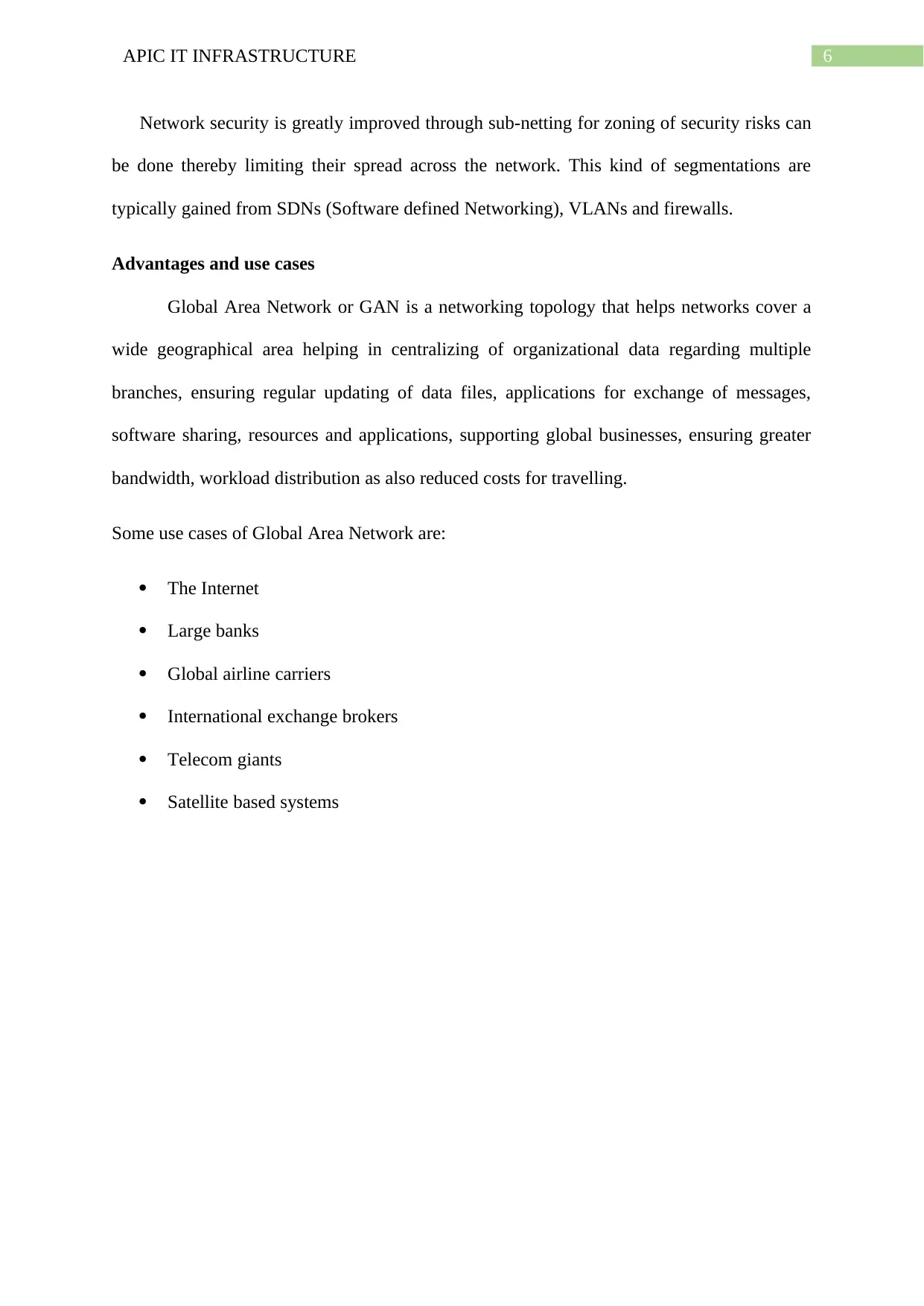
Network security is greatly improved through sub-netting for zoning of security risks can
be done thereby limiting their spread across the network. This kind of segmentations are
typically gained from SDNs (Software defined Networking), VLANs and firewalls.
Advantages and use cases
Global Area Network or GAN is a networking topology that helps networks cover a
wide geographical area helping in centralizing of organizational data regarding multiple
branches, ensuring regular updating of data files, applications for exchange of messages,
software sharing, resources and applications, supporting global businesses, ensuring greater
bandwidth, workload distribution as also reduced costs for travelling.
Some use cases of Global Area Network are:
The Internet
Large banks
Global airline carriers
International exchange brokers
Telecom giants
Satellite based systems
Paraphrase This Document
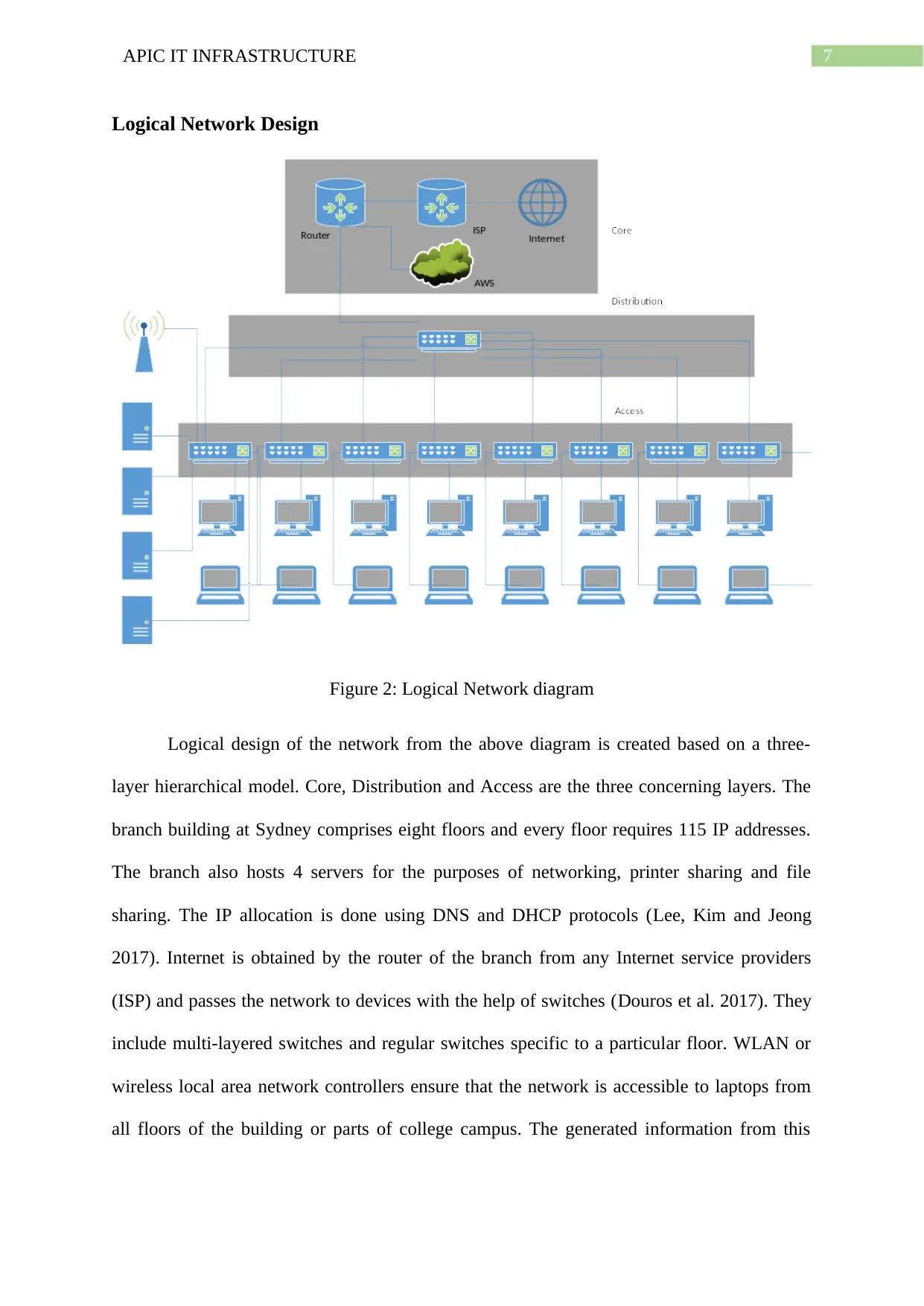
Logical Network Design
Figure 2: Logical Network diagram
Logical design of the network from the above diagram is created based on a three-
layer hierarchical model. Core, Distribution and Access are the three concerning layers. The
branch building at Sydney comprises eight floors and every floor requires 115 IP addresses.
The branch also hosts 4 servers for the purposes of networking, printer sharing and file
sharing. The IP allocation is done using DNS and DHCP protocols (Lee, Kim and Jeong
2017). Internet is obtained by the router of the branch from any Internet service providers
(ISP) and passes the network to devices with the help of switches (Douros et al. 2017). They
include multi-layered switches and regular switches specific to a particular floor. WLAN or
wireless local area network controllers ensure that the network is accessible to laptops from
all floors of the building or parts of college campus. The generated information from this
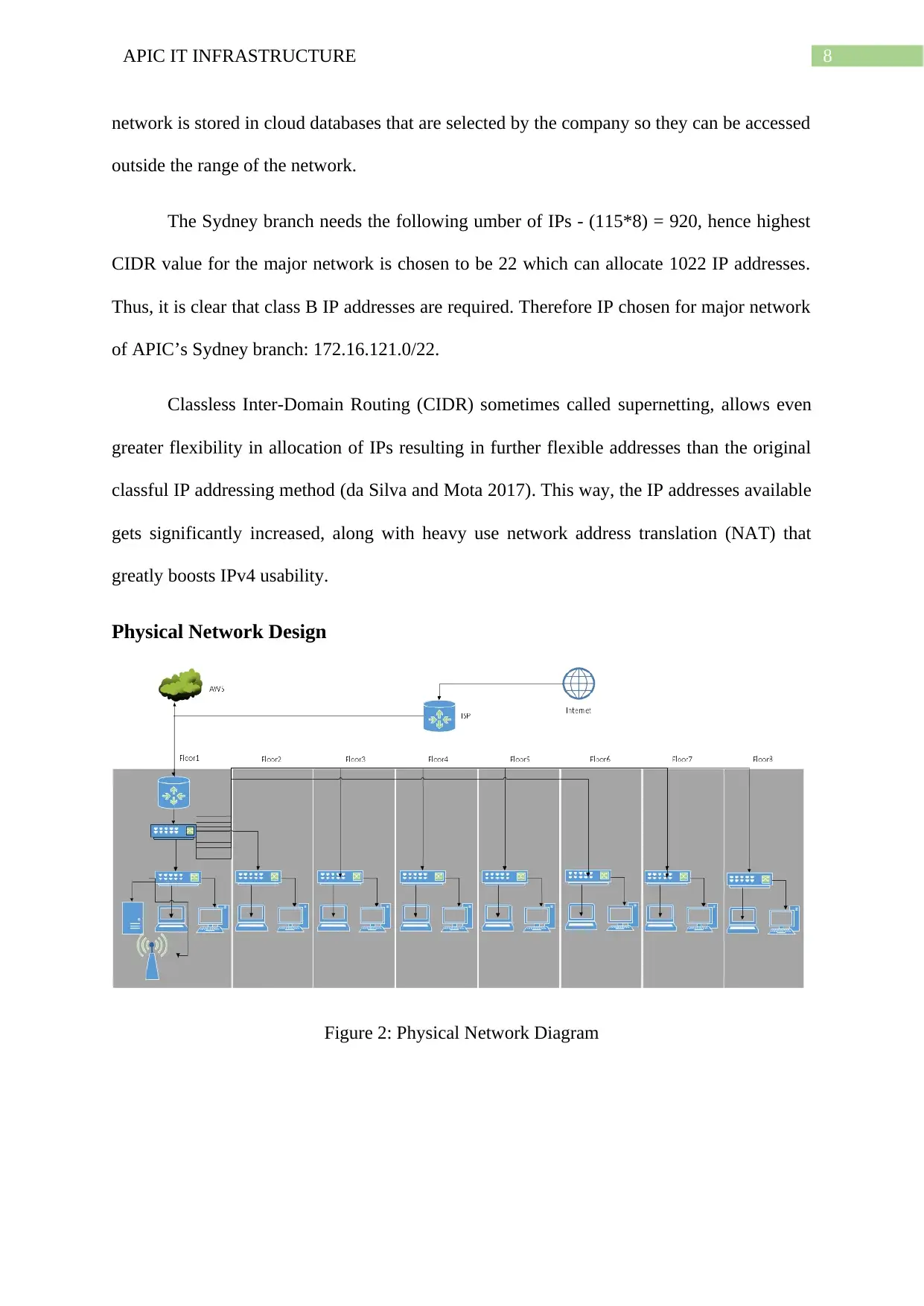
network is stored in cloud databases that are selected by the company so they can be accessed
outside the range of the network.
The Sydney branch needs the following umber of IPs - (115*8) = 920, hence highest
CIDR value for the major network is chosen to be 22 which can allocate 1022 IP addresses.
Thus, it is clear that class B IP addresses are required. Therefore IP chosen for major network
of APIC’s Sydney branch: 172.16.121.0/22.
Classless Inter-Domain Routing (CIDR) sometimes called supernetting, allows even
greater flexibility in allocation of IPs resulting in further flexible addresses than the original
classful IP addressing method (da Silva and Mota 2017). This way, the IP addresses available
gets significantly increased, along with heavy use network address translation (NAT) that
greatly boosts IPv4 usability.
Physical Network Design
Figure 2: Physical Network Diagram
⊘ This is a preview!⊘
Do you want full access?
Subscribe today to unlock all pages.

Trusted by 1+ million students worldwide
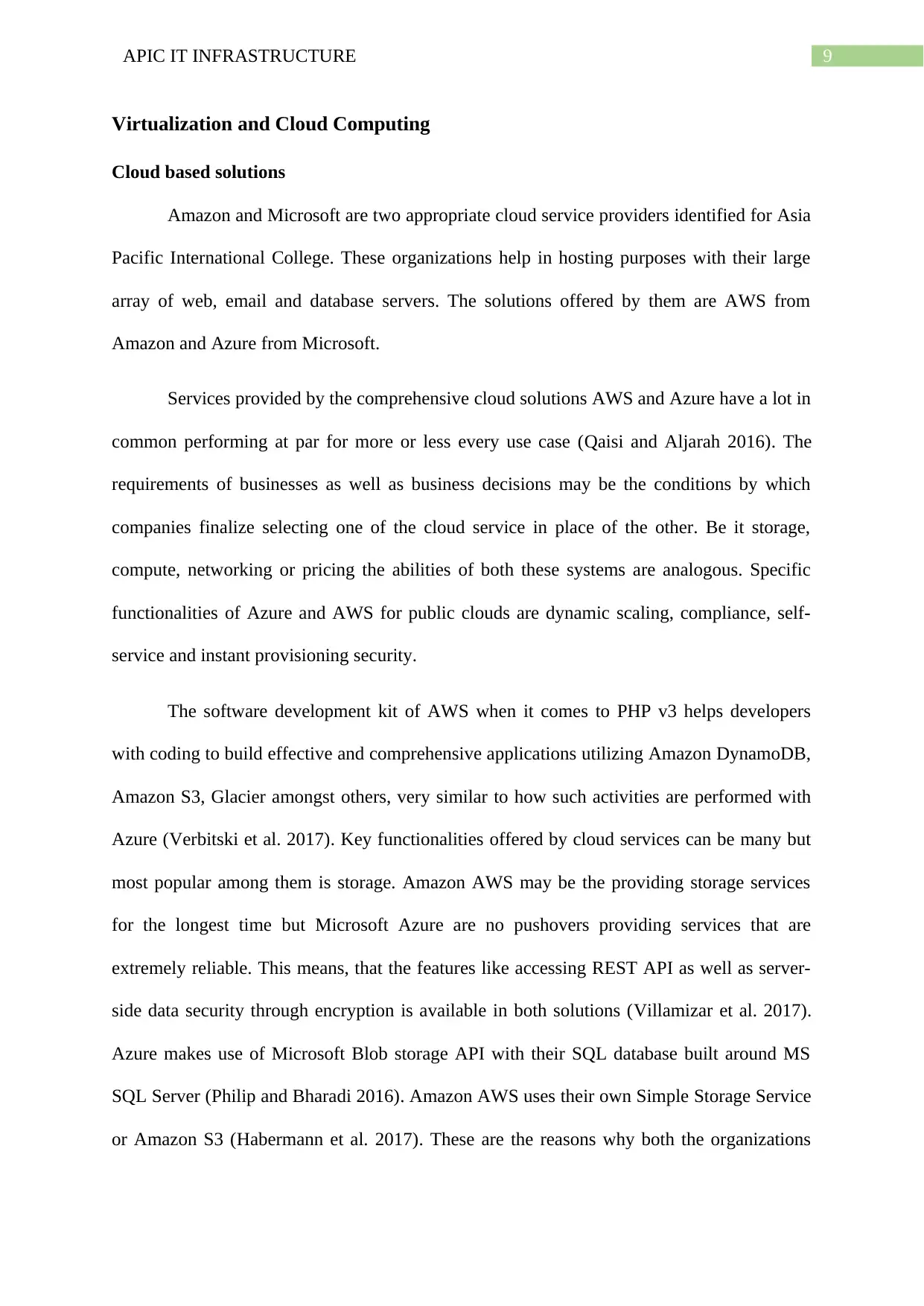
Virtualization and Cloud Computing
Cloud based solutions
Amazon and Microsoft are two appropriate cloud service providers identified for Asia
Pacific International College. These organizations help in hosting purposes with their large
array of web, email and database servers. The solutions offered by them are AWS from
Amazon and Azure from Microsoft.
Services provided by the comprehensive cloud solutions AWS and Azure have a lot in
common performing at par for more or less every use case (Qaisi and Aljarah 2016). The
requirements of businesses as well as business decisions may be the conditions by which
companies finalize selecting one of the cloud service in place of the other. Be it storage,
compute, networking or pricing the abilities of both these systems are analogous. Specific
functionalities of Azure and AWS for public clouds are dynamic scaling, compliance, self-
service and instant provisioning security.
The software development kit of AWS when it comes to PHP v3 helps developers
with coding to build effective and comprehensive applications utilizing Amazon DynamoDB,
Amazon S3, Glacier amongst others, very similar to how such activities are performed with
Azure (Verbitski et al. 2017). Key functionalities offered by cloud services can be many but
most popular among them is storage. Amazon AWS may be the providing storage services
for the longest time but Microsoft Azure are no pushovers providing services that are
extremely reliable. This means, that the features like accessing REST API as well as server-
side data security through encryption is available in both solutions (Villamizar et al. 2017).
Azure makes use of Microsoft Blob storage API with their SQL database built around MS
SQL Server (Philip and Bharadi 2016). Amazon AWS uses their own Simple Storage Service
or Amazon S3 (Habermann et al. 2017). These are the reasons why both the organizations
Paraphrase This Document

can be chosen for the email and web hosting purposes of Asia Pacific International College
and the two short listed solutions are Amazon AWS and Microsoft Azure.
Cloud Virtualization Techniques
The major methods of virtualizing in cloud services are network virtualization,
desktop virtualizing, storage virtualizing and application virtualization.
Network Virtualization: Through network virtualization available hardware and software
resources of cloud networks are combined into one administrative entity (Dalton et al. 2018).
Multiple virtual networks are operated with separate data plan. It is manageable by different
parties and ensures confidentiality. It also provides ability to operate with load balancers and
virtual private networks (VPN).
Storage Virtualizing: It involves a cluster of servers which are controlled by virtual storage
systems. The technique helps users pool storage spaces from multiple sources to a single
simulated repository managed using a command console. Here the servers have very little
information on where the data is stored (Malik, Wani, and Rashid 2018). Software
applications that enable storage virtualization maintain smooth and consistent performance as
well as comprehensive package of advanced features irrespective of the changes and
differences in underlying equipment.
Desktop Virtualizing: This allows the operating system of servers and client computers to
be remotely stored in the data centres. Thus, allowing the users in accessing their desktops
remotely from all locations (Shang et al. 2016). This can only be done in windows server
hence users requiring other operating systems will be needing virtual machines.
Application Virtualizations: This kind of virtualization involves remotely accessing of
applications from a different server (Andreadis, Fourtounis and Bouzakis 2015). Here the

concerned application can be run in an encapsulated form without depending upon operating
systems. As a result, the application becomes runnable on different operating systems also.
Dynamic Scaling in AWS (Auto Scaling)
Through the scaling strategy AWS Auto Scaling knows how optimum utilization of
resources can be done in the scaling plans (Liu, Buyya and Toosi 2018). Optimizations can
be done for availability, cost as also with balance of availability and cost. Alternatively, a
custom strategy can also be created according to the thresholds and metrics defined. One can
set multiple set of strategies for every resource or type of resource.
For all kinds of resources, auto scaling in AWS decides the specific metric that is
mostly used in determining amount of resources being used at any given time. To optimize
application performance with respect to the metric, appropriate scaling strategies need to be
selected. Enabling predictive and dynamic scaling helps in getting the scaling strategy shared
(Hwang et al. 2016). These scaling strategies are:
Availability: Resources are scaled in and out by auto scaling automatically to maintain
resource utilization at 40 percent. This is mostly useful when applications urgently or
sporadically require scaling features.
Availability and Costs: Resources are scaled out and back in by auto scaling, automatically
to maintain utilization of resources at 50 percent. This helps maintain higher availability
while also reducing the cost.
Costs: Resources are scaled out and back in by auto scaling, automatically for maintaining
utilization of resources at 70 percent. This generally becomes useful if costs have to be
slashed when application is able to operate with shrunken buffer sizes despite unexpected
changes are to occur.
⊘ This is a preview!⊘
Do you want full access?
Subscribe today to unlock all pages.

Trusted by 1+ million students worldwide
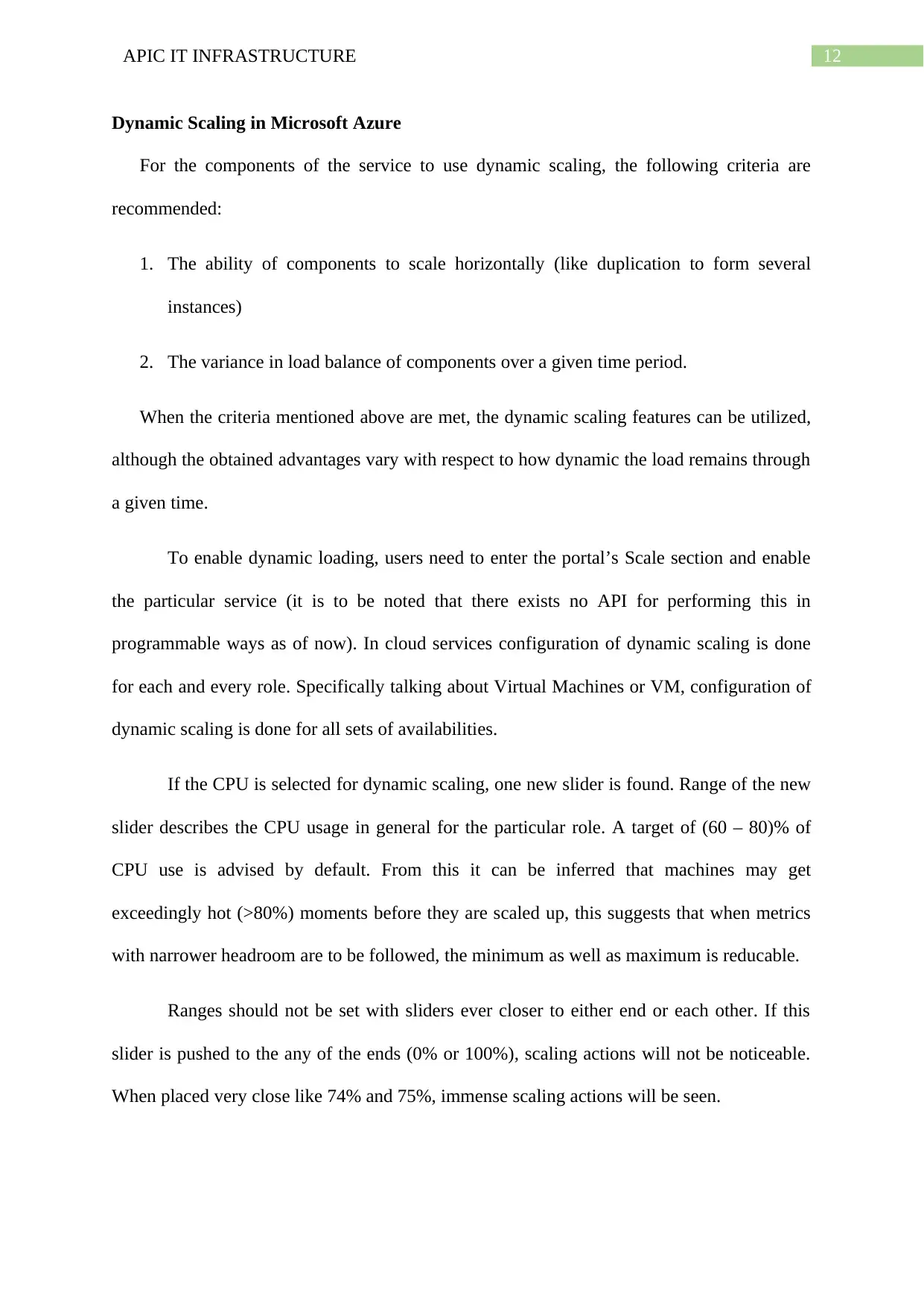
Dynamic Scaling in Microsoft Azure
For the components of the service to use dynamic scaling, the following criteria are
recommended:
1. The ability of components to scale horizontally (like duplication to form several
instances)
2. The variance in load balance of components over a given time period.
When the criteria mentioned above are met, the dynamic scaling features can be utilized,
although the obtained advantages vary with respect to how dynamic the load remains through
a given time.
To enable dynamic loading, users need to enter the portal’s Scale section and enable
the particular service (it is to be noted that there exists no API for performing this in
programmable ways as of now). In cloud services configuration of dynamic scaling is done
for each and every role. Specifically talking about Virtual Machines or VM, configuration of
dynamic scaling is done for all sets of availabilities.
If the CPU is selected for dynamic scaling, one new slider is found. Range of the new
slider describes the CPU usage in general for the particular role. A target of (60 – 80)% of
CPU use is advised by default. From this it can be inferred that machines may get
exceedingly hot (>80%) moments before they are scaled up, this suggests that when metrics
with narrower headroom are to be followed, the minimum as well as maximum is reducable.
Ranges should not be set with sliders ever closer to either end or each other. If this
slider is pushed to the any of the ends (0% or 100%), scaling actions will not be noticeable.
When placed very close like 74% and 75%, immense scaling actions will be seen.
Paraphrase This Document
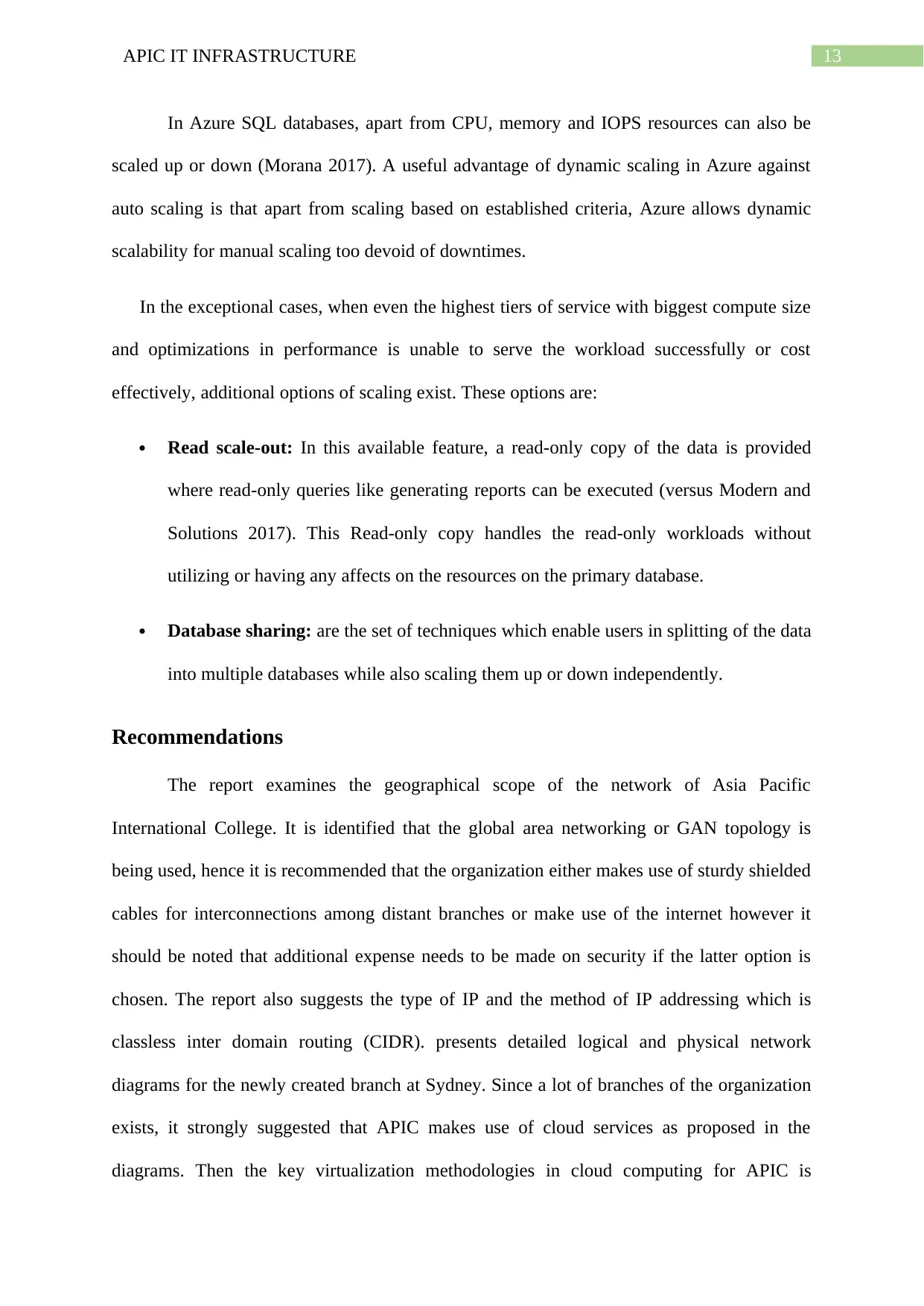
In Azure SQL databases, apart from CPU, memory and IOPS resources can also be
scaled up or down (Morana 2017). A useful advantage of dynamic scaling in Azure against
auto scaling is that apart from scaling based on established criteria, Azure allows dynamic
scalability for manual scaling too devoid of downtimes.
In the exceptional cases, when even the highest tiers of service with biggest compute size
and optimizations in performance is unable to serve the workload successfully or cost
effectively, additional options of scaling exist. These options are:
Read scale-out: In this available feature, a read-only copy of the data is provided
where read-only queries like generating reports can be executed (versus Modern and
Solutions 2017). This Read-only copy handles the read-only workloads without
utilizing or having any affects on the resources on the primary database.
Database sharing: are the set of techniques which enable users in splitting of the data
into multiple databases while also scaling them up or down independently.
Recommendations
The report examines the geographical scope of the network of Asia Pacific
International College. It is identified that the global area networking or GAN topology is
being used, hence it is recommended that the organization either makes use of sturdy shielded
cables for interconnections among distant branches or make use of the internet however it
should be noted that additional expense needs to be made on security if the latter option is
chosen. The report also suggests the type of IP and the method of IP addressing which is
classless inter domain routing (CIDR). presents detailed logical and physical network
diagrams for the newly created branch at Sydney. Since a lot of branches of the organization
exists, it strongly suggested that APIC makes use of cloud services as proposed in the
diagrams. Then the key virtualization methodologies in cloud computing for APIC is
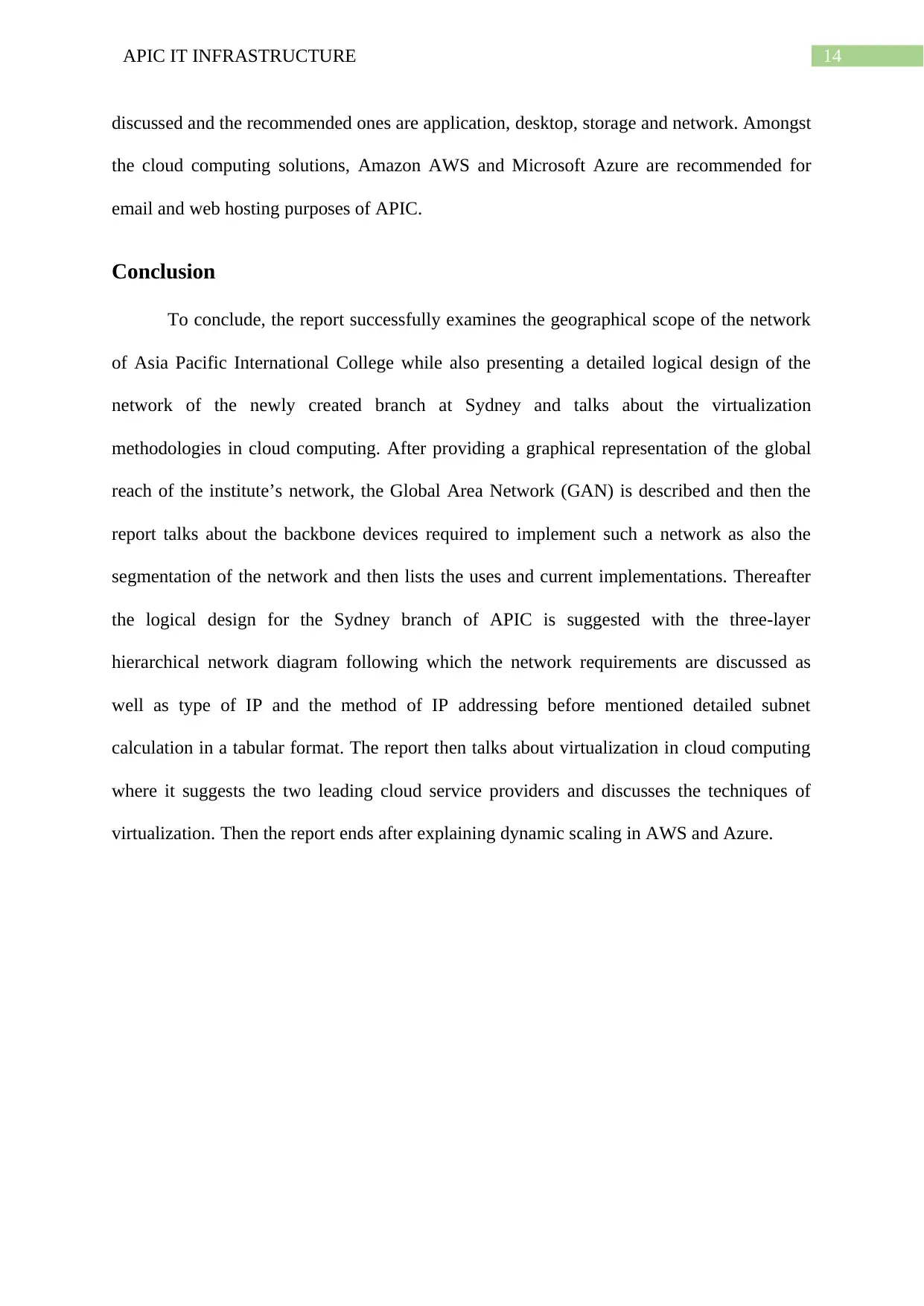
discussed and the recommended ones are application, desktop, storage and network. Amongst
the cloud computing solutions, Amazon AWS and Microsoft Azure are recommended for
email and web hosting purposes of APIC.
Conclusion
To conclude, the report successfully examines the geographical scope of the network
of Asia Pacific International College while also presenting a detailed logical design of the
network of the newly created branch at Sydney and talks about the virtualization
methodologies in cloud computing. After providing a graphical representation of the global
reach of the institute’s network, the Global Area Network (GAN) is described and then the
report talks about the backbone devices required to implement such a network as also the
segmentation of the network and then lists the uses and current implementations. Thereafter
the logical design for the Sydney branch of APIC is suggested with the three-layer
hierarchical network diagram following which the network requirements are discussed as
well as type of IP and the method of IP addressing before mentioned detailed subnet
calculation in a tabular format. The report then talks about virtualization in cloud computing
where it suggests the two leading cloud service providers and discusses the techniques of
virtualization. Then the report ends after explaining dynamic scaling in AWS and Azure.
⊘ This is a preview!⊘
Do you want full access?
Subscribe today to unlock all pages.

Trusted by 1+ million students worldwide
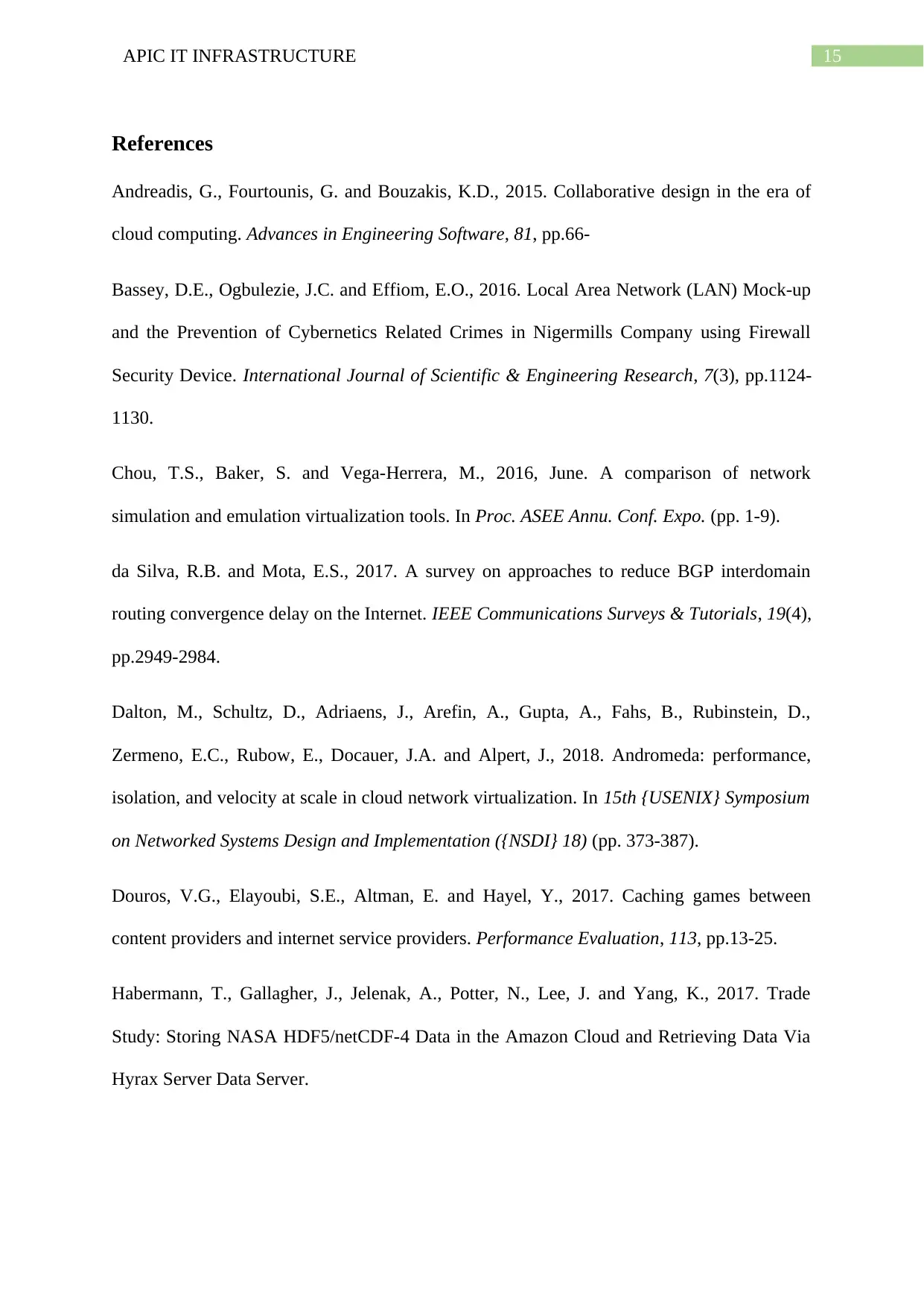
References
Andreadis, G., Fourtounis, G. and Bouzakis, K.D., 2015. Collaborative design in the era of
cloud computing. Advances in Engineering Software, 81, pp.66-
Bassey, D.E., Ogbulezie, J.C. and Effiom, E.O., 2016. Local Area Network (LAN) Mock-up
and the Prevention of Cybernetics Related Crimes in Nigermills Company using Firewall
Security Device. International Journal of Scientific & Engineering Research, 7(3), pp.1124-
1130.
Chou, T.S., Baker, S. and Vega-Herrera, M., 2016, June. A comparison of network
simulation and emulation virtualization tools. In Proc. ASEE Annu. Conf. Expo. (pp. 1-9).
da Silva, R.B. and Mota, E.S., 2017. A survey on approaches to reduce BGP interdomain
routing convergence delay on the Internet. IEEE Communications Surveys & Tutorials, 19(4),
pp.2949-2984.
Dalton, M., Schultz, D., Adriaens, J., Arefin, A., Gupta, A., Fahs, B., Rubinstein, D.,
Zermeno, E.C., Rubow, E., Docauer, J.A. and Alpert, J., 2018. Andromeda: performance,
isolation, and velocity at scale in cloud network virtualization. In 15th {USENIX} Symposium
on Networked Systems Design and Implementation ({NSDI} 18) (pp. 373-387).
Douros, V.G., Elayoubi, S.E., Altman, E. and Hayel, Y., 2017. Caching games between
content providers and internet service providers. Performance Evaluation, 113, pp.13-25.
Habermann, T., Gallagher, J., Jelenak, A., Potter, N., Lee, J. and Yang, K., 2017. Trade
Study: Storing NASA HDF5/netCDF-4 Data in the Amazon Cloud and Retrieving Data Via
Hyrax Server Data Server.
Paraphrase This Document
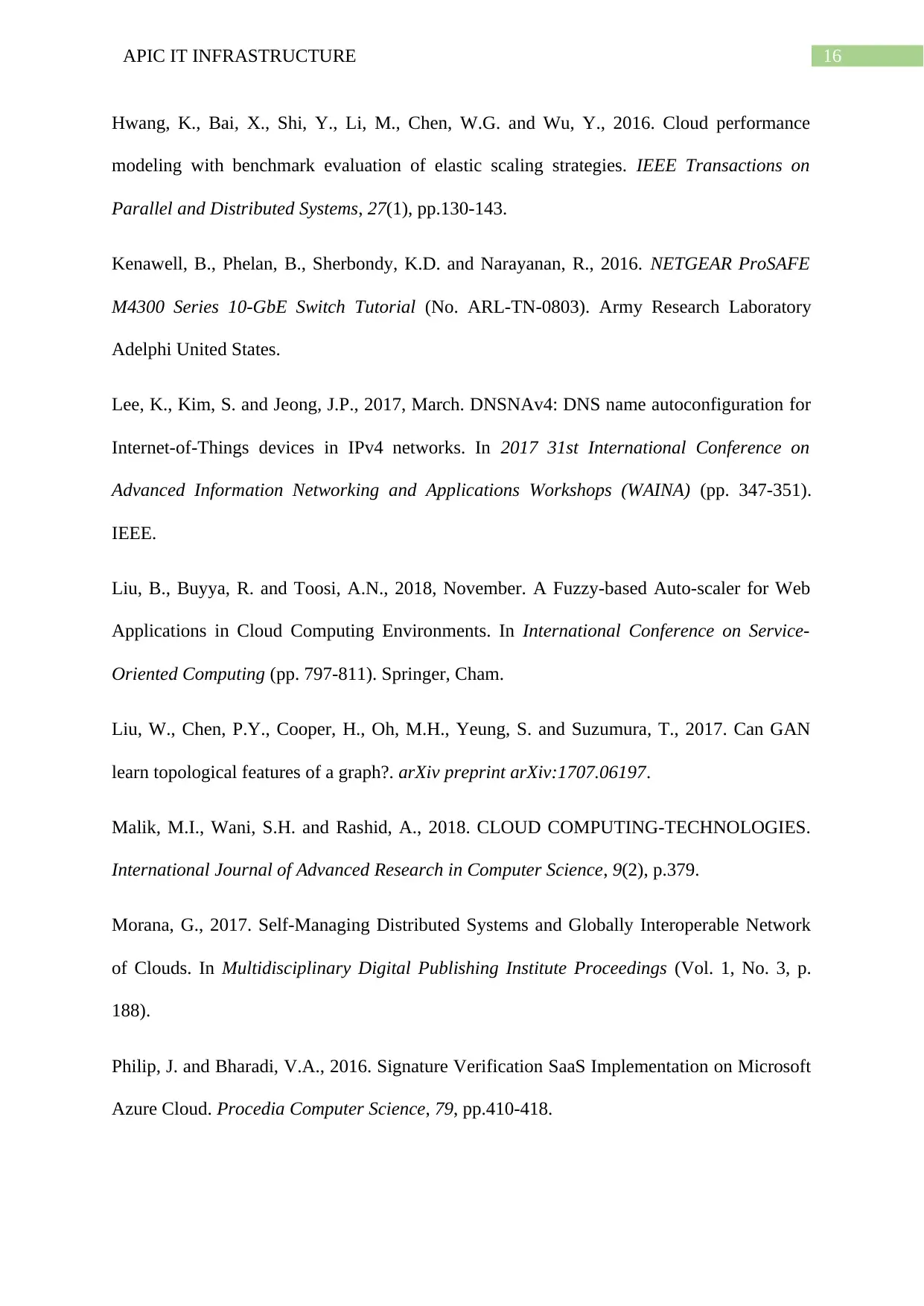
Hwang, K., Bai, X., Shi, Y., Li, M., Chen, W.G. and Wu, Y., 2016. Cloud performance
modeling with benchmark evaluation of elastic scaling strategies. IEEE Transactions on
Parallel and Distributed Systems, 27(1), pp.130-143.
Kenawell, B., Phelan, B., Sherbondy, K.D. and Narayanan, R., 2016. NETGEAR ProSAFE
M4300 Series 10-GbE Switch Tutorial (No. ARL-TN-0803). Army Research Laboratory
Adelphi United States.
Lee, K., Kim, S. and Jeong, J.P., 2017, March. DNSNAv4: DNS name autoconfiguration for
Internet-of-Things devices in IPv4 networks. In 2017 31st International Conference on
Advanced Information Networking and Applications Workshops (WAINA) (pp. 347-351).
IEEE.
Liu, B., Buyya, R. and Toosi, A.N., 2018, November. A Fuzzy-based Auto-scaler for Web
Applications in Cloud Computing Environments. In International Conference on Service-
Oriented Computing (pp. 797-811). Springer, Cham.
Liu, W., Chen, P.Y., Cooper, H., Oh, M.H., Yeung, S. and Suzumura, T., 2017. Can GAN
learn topological features of a graph?. arXiv preprint arXiv:1707.06197.
Malik, M.I., Wani, S.H. and Rashid, A., 2018. CLOUD COMPUTING-TECHNOLOGIES.
International Journal of Advanced Research in Computer Science, 9(2), p.379.
Morana, G., 2017. Self-Managing Distributed Systems and Globally Interoperable Network
of Clouds. In Multidisciplinary Digital Publishing Institute Proceedings (Vol. 1, No. 3, p.
188).
Philip, J. and Bharadi, V.A., 2016. Signature Verification SaaS Implementation on Microsoft
Azure Cloud. Procedia Computer Science, 79, pp.410-418.
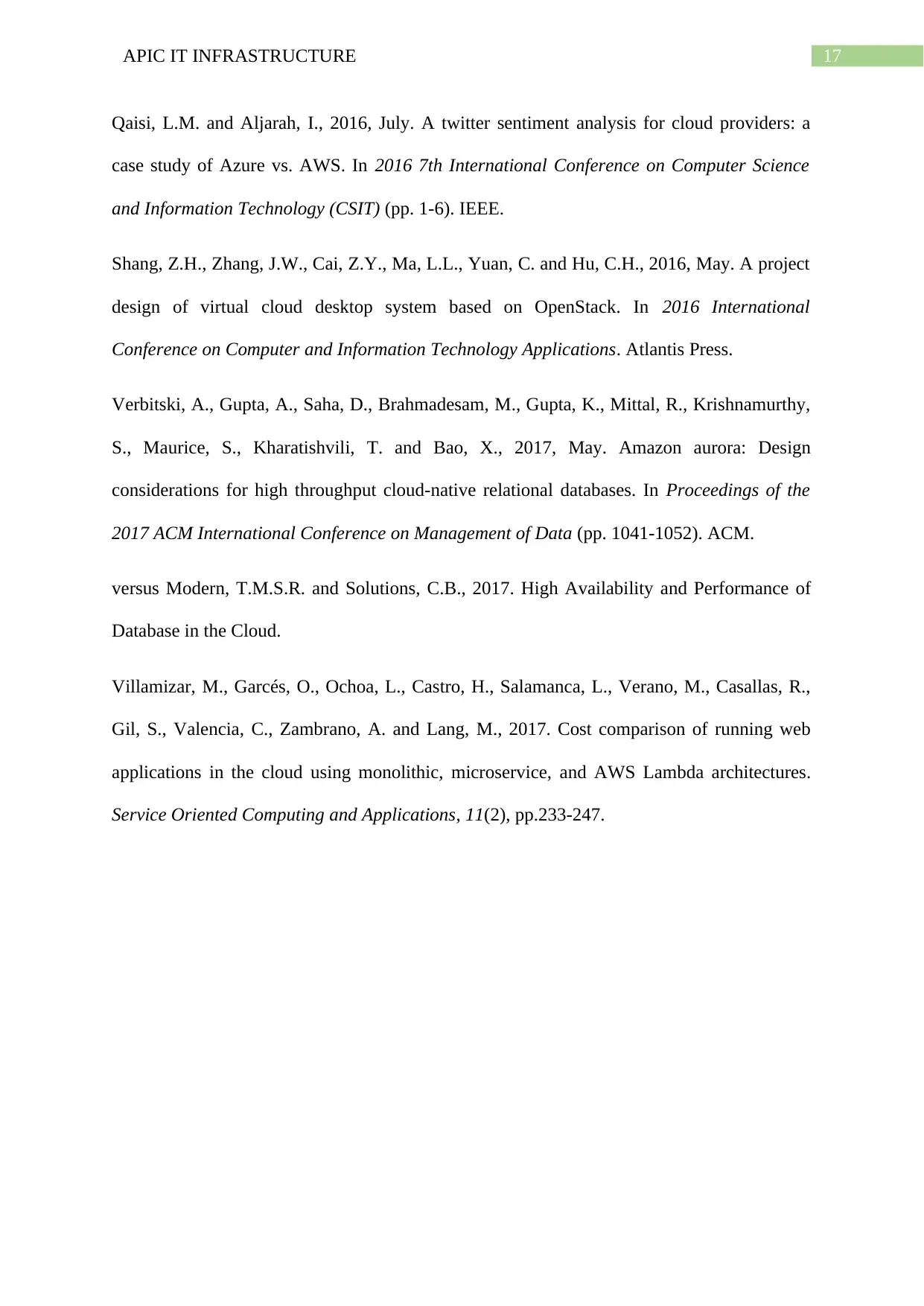
Qaisi, L.M. and Aljarah, I., 2016, July. A twitter sentiment analysis for cloud providers: a
case study of Azure vs. AWS. In 2016 7th International Conference on Computer Science
and Information Technology (CSIT) (pp. 1-6). IEEE.
Shang, Z.H., Zhang, J.W., Cai, Z.Y., Ma, L.L., Yuan, C. and Hu, C.H., 2016, May. A project
design of virtual cloud desktop system based on OpenStack. In 2016 International
Conference on Computer and Information Technology Applications. Atlantis Press.
Verbitski, A., Gupta, A., Saha, D., Brahmadesam, M., Gupta, K., Mittal, R., Krishnamurthy,
S., Maurice, S., Kharatishvili, T. and Bao, X., 2017, May. Amazon aurora: Design
considerations for high throughput cloud-native relational databases. In Proceedings of the
2017 ACM International Conference on Management of Data (pp. 1041-1052). ACM.
versus Modern, T.M.S.R. and Solutions, C.B., 2017. High Availability and Performance of
Database in the Cloud.
Villamizar, M., Garcés, O., Ochoa, L., Castro, H., Salamanca, L., Verano, M., Casallas, R.,
Gil, S., Valencia, C., Zambrano, A. and Lang, M., 2017. Cost comparison of running web
applications in the cloud using monolithic, microservice, and AWS Lambda architectures.
Service Oriented Computing and Applications, 11(2), pp.233-247.
⊘ This is a preview!⊘
Do you want full access?
Subscribe today to unlock all pages.

Trusted by 1+ million students worldwide

Related Documents
Your All-in-One AI-Powered Toolkit for Academic Success.
+13062052269
info@desklib.com
Available 24*7 on WhatsApp / Email
![[object Object]](/_next/static/media/star-bottom.7253800d.svg)
© 2024 | Zucol Services PVT LTD | All rights reserved.





